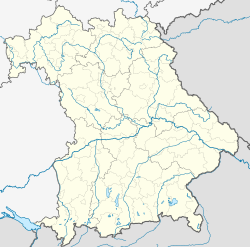Bad Windsheim
Bad Windsheim (German pronunciation: [baːt ˈvɪntsˌhaɪm] ⓘ; East Franconian: Winsa) is a historic town in Bavaria, Germany with a population of more than 12,000. It lies in the district Neustadt an der Aisch-Bad Windsheim, west of Nuremberg. In the Holy Roman Empire, Windsheim held the rank of Imperial City (until 1802). Since 1810 Windsheim is part of Bavaria. In 1961, it became a spa town and has since been called "Bad Windsheim". ClimateThe climate in this area shows only small differences between highs and lows, and there is adequate rainfall year-round. The Köppen Climate Classification subtype for this climate is "Cfb" (Marine West Coast Climate/Oceanic climate).[3] HistoryA document from 741 proves for the first time the existence of the town, then called Uuinidesheim. The name changed to "Windsheim" by linguistic development, meaning "the home of the wind". In the late stage of World War II, a Volkssturm battalion took control of the town and refused to surrender to the approaching American troops, declaring Windsheim a "fortress". Demonstrations led by a number of women demanding the local Nazi representative in the town to uphold orders for the destruction of Bad Windsheim ahead of the Allied approach (early April 1945). American troops eventually captured the town after deploying fire bombs through aerial bombing. The civilian population was forced to flee from Windsheim under enemy fire. The town was rebuilt after the war. AttractionsThe town is known for its waters and spa, Franken-Therme, and an open-air museum, the Freilandmuseum, which brings together old farms and farmhouses from the area. On the first weekend in August every year Bad Windsheim is the location for an event called Weinturm Open Air, a concert on the top of a hill in the town. The town also features a war memorial in the form of a large statue of Roland. Notable peopleSons and daughters of the town
Personalities who worked locally
References
External linksWikimedia Commons has media related to Bad Windsheim.
|
||||||||||||||||||||||||||||||||||||||||||||||||||||





















